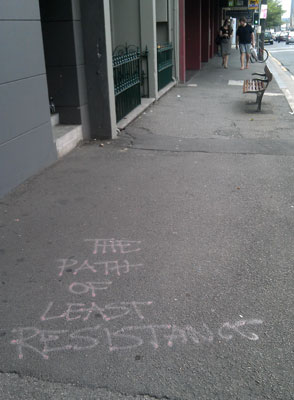Here’s another one of those pedantic vocabulary posts. We’ve already done ‘sgraffito/ graffiti’ and ‘palimpsest’. Now it’s time to do ‘pavement’ because I got another email this week querying why I use that term. In Australia, says my correspondent, we more commonly use the term ‘footpath’.  Trouble is, dear correspondent, that this blog – and indeed my whole Pavement graffiti project – is meant for an international audience, and in any case I’m obsessed with graffiti not only on places where people walk, but also on the hard surfaces where they normally drive, ride, skate and park.
It’s a tricky problem of vocabulary that I have never properly resolved. But here is how I justified using the term ‘pavement’ in my thesis. It comes with a lengthy footnote:
“By ‘pavement’ I mean hard, paved surfaces in public places. These include roads (or ‘carriageways’ in older terminology), footpaths (‘footways’ in older Australian terminology, ‘sidewalks’ in America), public squares and parking lots. Their paving materials range from cobblestones and flagstones to tarmacadam, asphalt and concrete.
“Footnote: The term ‘pavement’ can be problematic in that usage varies across English-speaking countries. Respondents to my blog, Pavement graffiti, have pointed out that people in Britain usually think of the pavement as a paved footway; in Australia this seems to be the more generally accepted meaning as well, although the term ‘footpath’ is more widely used. In American English the term ‘pavement’ is used for ‘the durable surface material laid down on an area intended to sustain vehicular or foot traffic, such as a road or walkway’ (see the entry for Road surface in Wikipedia, accessed 3 March 2013).
“The Oxford English Dictionary’s list of definitions of ‘pavement’ covers all these uses. Condensed, the OED’s meanings (excluding the specialised mining and zoological uses), are: a paved surface or hard covering laid on the ground (used chiefly in technical contexts); paving or similar surfacing (used as a mass noun); the paved or metalled part of a road or other public thoroughfare or the roadway (used chiefly in North America and in Engineering); a paved footpath alongside a street or road (but the preferred term in North America is ‘sidewalk’) (see the entry for pavement in OED Online, Oxford University Press, accessed 20 March 2013).
“In my extensive reading of current as well as older references – mainly from Australia, but also from Britain and USA – I have seen the term ‘pavement’ variously used by both engineers and laypeople to refer to the paved surfaces of roads, of footpaths alone, and of roads and footpaths. For my project I have chosen to use ‘pavement’ in this last, broad sense because it is the only term available that can collectively refer to all the different kinds of hard surface laid down on the ground for ease of passage, whether by wheels, feet or hooves.â€
Does that help?

